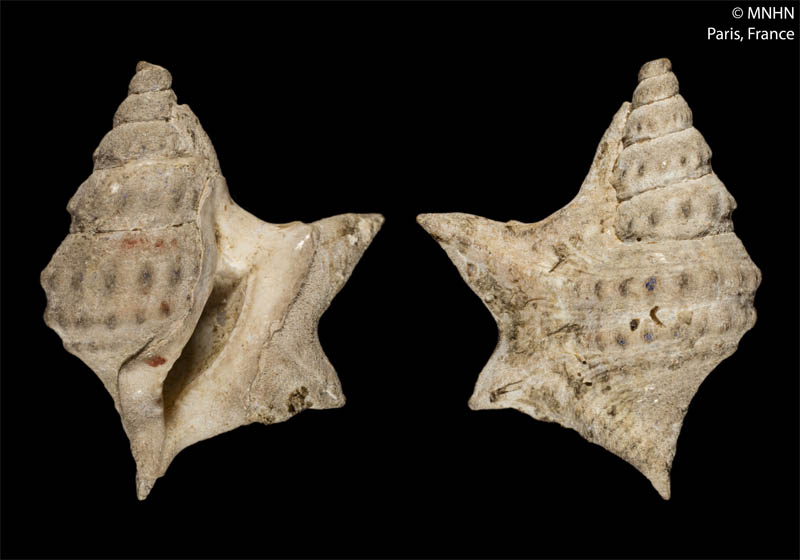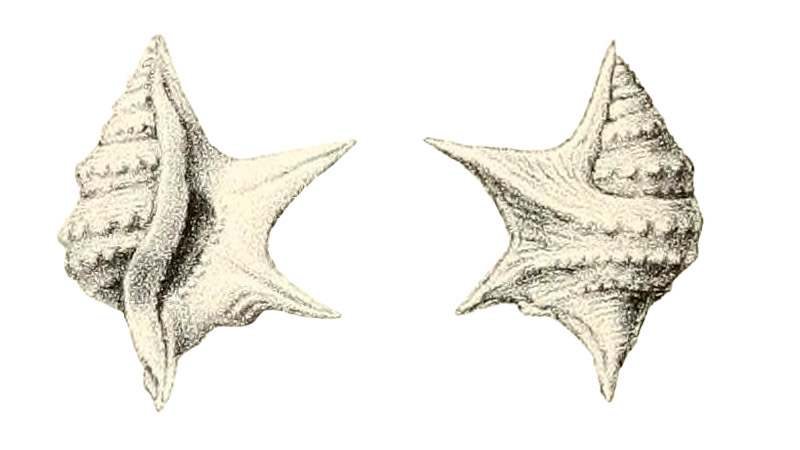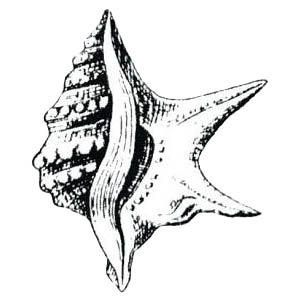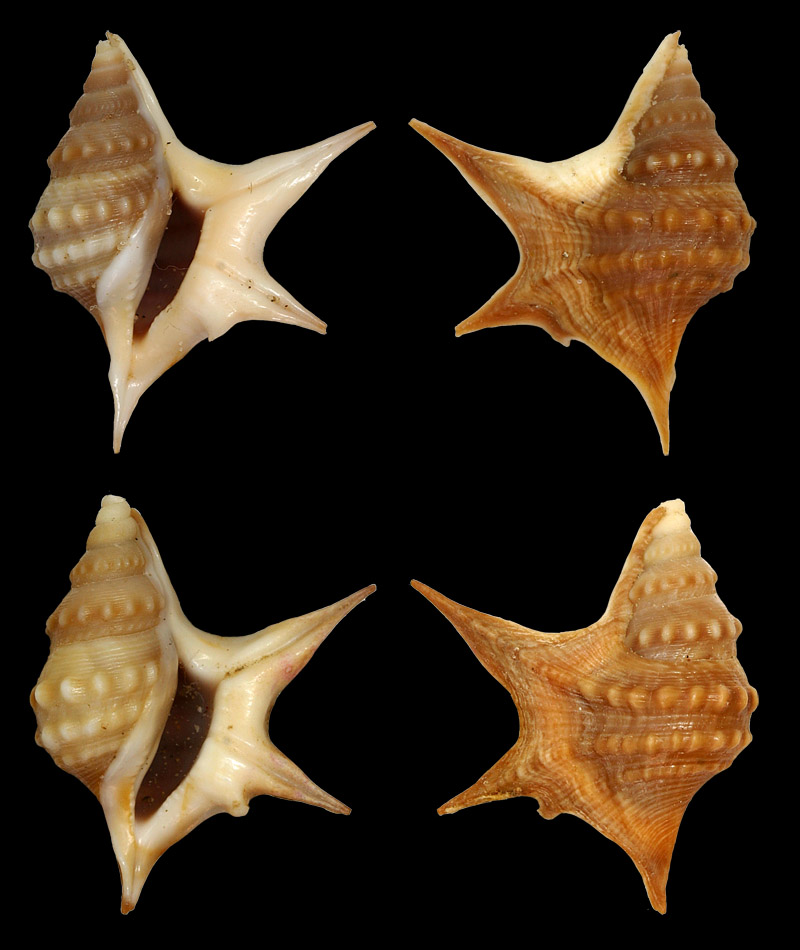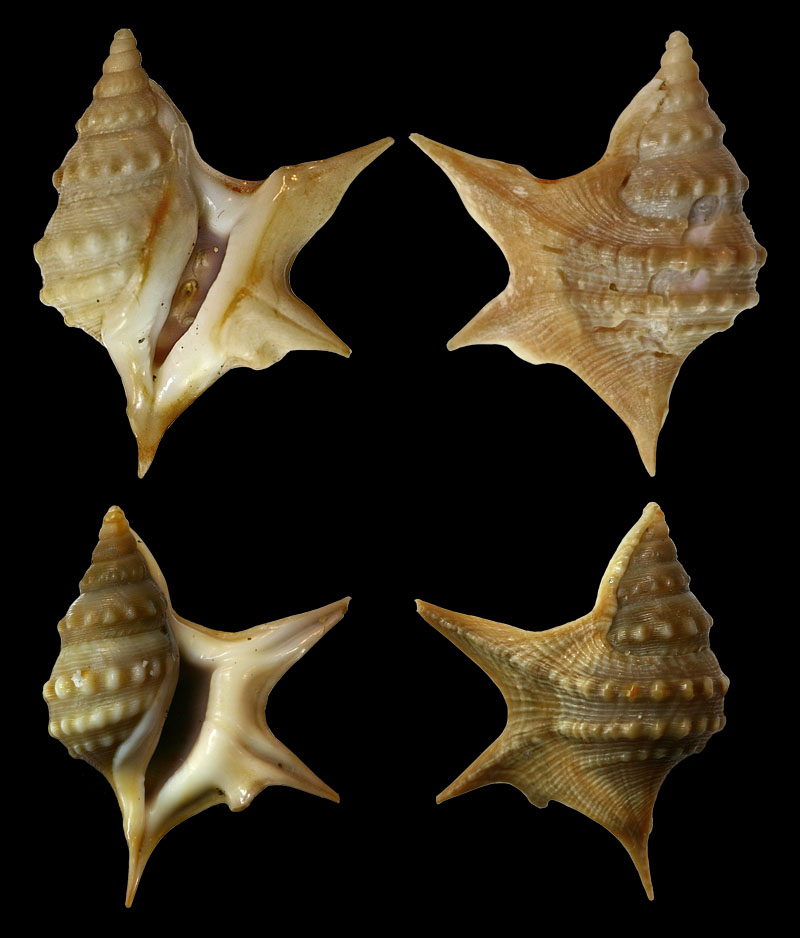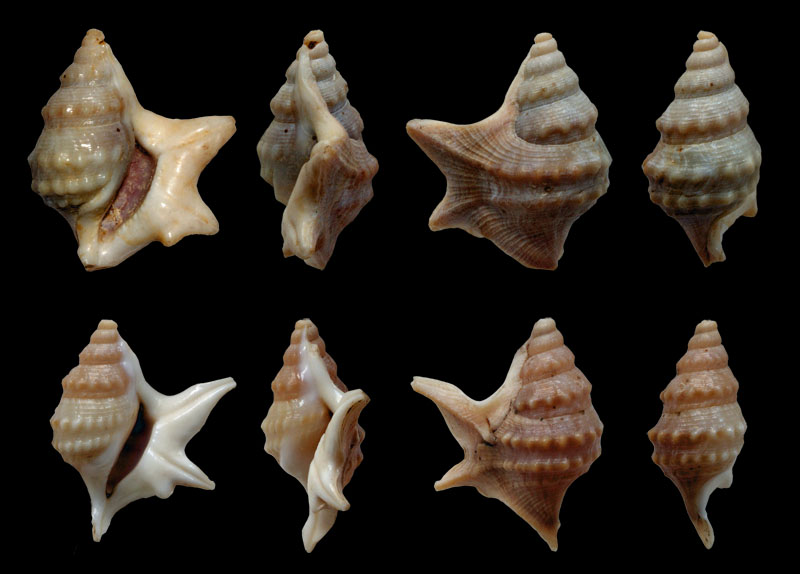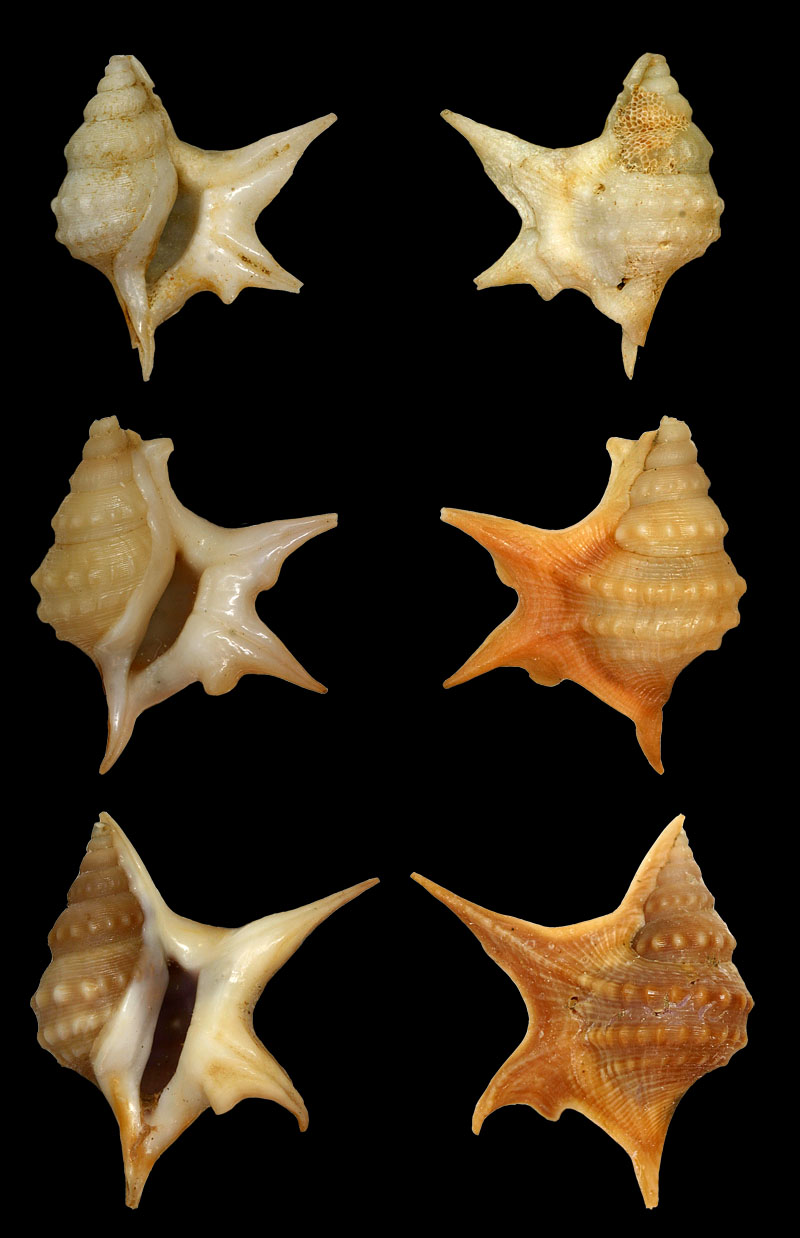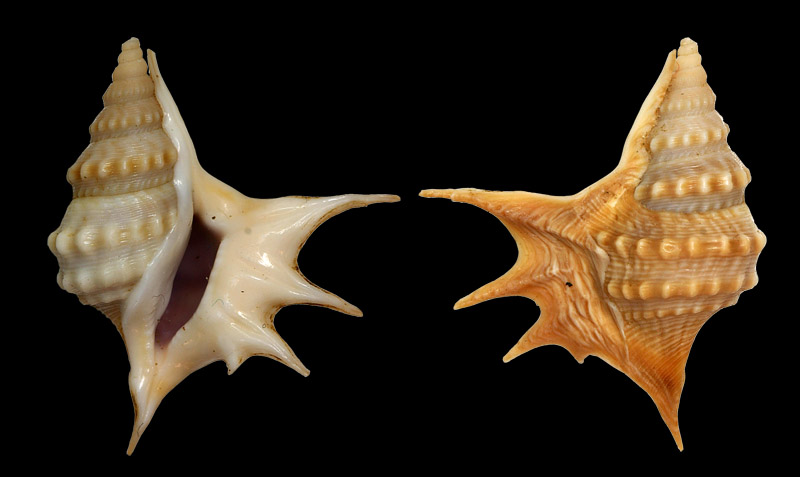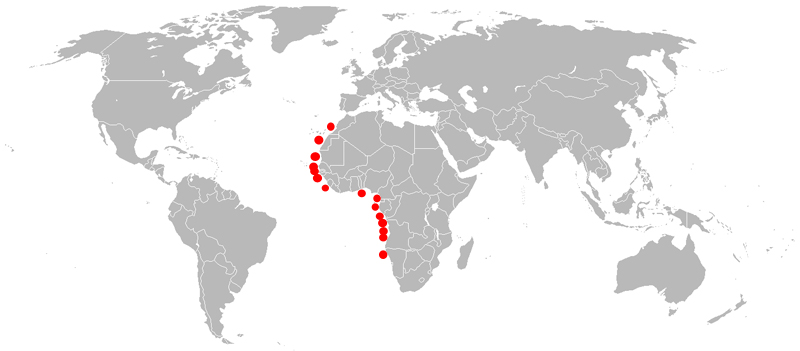|
edit SideBar
|
Species / Aporrhais Senegalensis
Stromboidea
Original Description of Apporrhais [sic] senegalensis by Gray, 1838, p. 27:
- "Shell regular, spirally striated; the upper whorls with one central, and the last with two subcentral, series of small nodules, with a series of much smaller tubercles in front of them; outer lip, with two acute expanded lobes. Axis 13''' (= 1 1/12 inch). Sierra Leone."
Locus typicus: Sierra Leone, West Africa (Gray, 1838:27)
Types:
- Aporrhais senegalensis: as Apporrhais [sic!] senegalensis J. E. GRAY, 1838, Natural History Museum London, holotype registration no. NHMUK 20190011, locality: Sierra Leone, GRAY collection,
- Aporrhais francheti: holotype MNHN-IM-2000-32470, (« Embouchure de la Casamance, par 150 mètres de profondeur » DE ROCHEBRUNE, 1883: 178),
Gray, 1838 gave no drawing.
History and Synonymy
Aporrhais senegalensis (Gray, 1838: 27) [as Apporrhais [sic] senegalensis]
- syn. Aporrhais Francheti de Rochebrune, 1883:178
- syn. Aporrhais gambiensis MS de Rochebrune Lamy, 1911:316 [not available, ICZN 11.6.].
- syn. Aporrhais pes-pelicani Tryon, 1883: 132.
- syn. Aporrhais pespelecani Carpenter & de Angelis, 2016: 1001.
- non Aporrhais senegalensis – Lindner, 1982:138 [= juvenile Aporrhais elegantissima].
1839
Troschel, 1839, p. 229:
- "Aporrhais Senegalensis Gray (Annals Nat. Hist. etc. l. p. 27) Schale regelmässig quergestreift, die obern Windungen mit einer, die letzte mit zwei Reihen Knoten, vor denen noch eine Reihe viel kleinerer Höcker; Aussenlippe mit zwei spitz vorstehenden Lappen. Axe 13´´´. Sierra Leone."
- german translation of Gray, 1838
1865
Mörch, 1865, p. 388:
- "In Senegal is found A. senegalensis, Gray. The most northern species is the largest of the genus, as is generally the case; the outside of the outer lip is smooth, as in all other arctic univalves. In A. pes-pelecani and the following southern species the inside lip is plaited, as is generally the case in species of warmer climes (e.g. Nassa and other univalves). The A. senegalensis, living in the hottest water, is the smallest. Unfortunately it will be very difficult to get the tongues of these species."
1883
Tryon, 1883, p. 132:
- "A. senegalensis, Gray. (Unfigured.) Senegal. The (insufficient) description indicates close affinity or identity with A. pes-pelicani."
Description of Aporrhais Francheti by de Rochebrune, 1883, p. 178:
- "A. — Testa fusiformi, crassissima, cinereo, cœrulea; spira abbreviata, anfractibus 6, disjunctis, lœvibus, medio rotundatis, ad basin oblique nodosis; nodis obliquis; anfractu ultimo tricarinato, carinis duabus anterioribus, nodiferis , nodis rotundatis, intervallis lyratis; in alam bidactylam expenso; dactylo anteriore triangulari, recto acuminato; inferiore brevi, obtuso; apertura obliqua, augustissima; columella sub incrassata, alba; labro externo tumido. Long. 0,021; lat. 0,017."
- "Hab. — Embouchure de la Casamence, par 150 mètres de profondeur."
Aporrhais Francheti de Rochebrune, 1883, holotype; Coll. MNHN-IM-2000-32470, Copyright Muséum National d'Histoire Naturelle Paris MNHN
1891
Description of Chenopus senegalensis by Dautzenberg, 1891, p. 43:
- "Testa 24 millim. alta, 18 millim. lata, crassissima. Anfractus 8 convexi, transversim dense striati: primi quatuor rotundati, sequentes tres carina nodulosa et ultimus carinis tribus nodulosis ornati. Apertura angusta; columella callosa, subrecta; labrum callosum expansum, margine interno crenulato et digitis quatuor acutis, divaricatis, munitum: supero spirae adnato. Color griseus, apertura alba, nitida."
- "Coquille très épaisse, à spire élevée, turriculée, composée de huit tours convexes ornés de cordons décurrents nombreux et étroits. Les quatre premiers tours sont arrondis et ne portent aucune trace de carène; les trois suivants sont pourvus d'une carène médiane garnie de petits tubercules arrondis. Sur la convexité du dernier tour, on voit deux carènes principales tuberculeuses, qui se prolongent ensuite sur la face externe des digitations du labre, en crêtes non tuberculeuses. Une troisième carène, plus faible, règne au-dessous des deux autres et porte des tubercules moins saillants. Ouverture allongée, étroite, anguleuse à la base. Bord columellaire un peu sinueux, dirigé obliquement et pourvu d"une callosité appliquée, épaisse et luisante, nettement limitée. Labre dilaté, armé de digitations divergentes fortes, acuminées et canaliculées. La digitation supérieure est complètement soudée à la spire et son extrémité en dépasse à peine le sommet. Des deux digitations suivantes, la supérieure est la plus robuste, et on observe, immédiatement au-dessous de la seconde, un dentelon obtus qui n'est autre chose qu'une digitation rudimentaire, correspondant à la carène inférieure du dernier tour. La quatrième digitation est pointue et formée par la soudure des extrémités de la columelle et du labre. Le bord interne du labre présente une série de crénelures, plus ou moins obsolètes chez les individus très adultes, mais toujours visibles. Coloration d'un gris sale, callosités de l'ouverture formées d'un émail blanc très luisant."
Locality:
- "Stn. 73. Lat. N. 17° 02'; Long. O. 18° 59'. Dragage chalut et fauberts par 80 mètres. Fond de vase verte." (31.1.1890)
Chenopus senegalensis in Dautzenberg, 1891, pl. 3, fig. 5 a, b
Comment Dautzenberg, 1891, p. 44:
- "Trop sommairement décrite par Gray, cette espèce est restée assez peu connue jusqu'à ce jour pour que M. Tryon ait cru qu'il ne s'agissait là que d'une variété du Ch. pespelecani Linné. Les nombreux spécimens recueillis par M. Chevreux prouvent, au contraire, que le Ch. senegalensis est absolument différent de cette espèce européenne. La digitation supérieure soudée dans toute son étendue, l'épaisseur du test, le développement excessif des callosités de l'ouverture, la petite taille et les crénelures du labre, constituent un ensemble de caractères amplement suffisant pour motiver une séparation spécifique. Certaines formes du pliocène d'Italie connues sous le nom de pespelecani, possèdent aussi des crénelures au labre et semblent indiquer un passage entre les deux espèces; mais, chez ces fossiles, la digitation supérieure est toujours détachée de l'extrémité de la spire, comme chez le Ch. pespelecani de l'époque actuelle."
1893
Sacco, 1893:30
- "Il carattere del labbro denticulato non ha, a mio parere quell'importanza che parrebbe a primo tratto, giacché lo si vede apparire, quantunque appena accennato, su diverse forme di C. pespelicani specialmente nella parte inferiore del labbro; la varietà in esame collegasi insensibilmente colle var. minor e parvecincta. D'altronde tali denticolazioni labiali riscontransi pure nel gruppo del C. uttingerianus, così nella var. miodenticulata. Fra le forme viventi il C. senegalensis Gray presenta tale carattere assai accentuato."
1910
Dautzenberg, 1910, p.70:
- "Mission Gruvel, Campagne de 1909. Drag. Baie de Rufisque, 18-20 mètres. Dispersion. Sénégal."
1911
E.Lamy, 1911, p.316*
- Aporrhais Francheti Rochbr. Avec les autres types de Sénegambie étudiés par le Dr de Rochebrune, se trouvait une coquille étiquetée de sa main Aporrhais gambiensis, dont les dimensions, longueur, 21 millimètres, largeur, 17 millimètres, sont exactement celles qu'il a indiquées pour son A. Francheti: c'est fort probablement le type de celle dernière espèce dont le nom aura été changé par l'auteur lui-même. En tout cas, cette coquille, dont le labre a son bord interne muni de crénelures et sa digitation supérieure complètement soudée à la spire, doit être identifiée à l'A. senegalensis Gray (1891, Dautzenberg, Voy. "Melita" au Sénégal, Mém. Soc. Zool. France, IV, p. 43, pl. III, fig. 5 a-b).
1950
Aporrhais senegalensis in Nicklès, 1950, fig. 105
1956
Comment Dodge, 1956:
- p. 246: "Aporrhais senegalensis Gray (1838, p. 27) was the third species mentioned by Jeffreys. Tryon (loc. cit.) felt that it was either identical with pes-pelicani or closely allied to it. Gray described it as: "Shell regular, spirally striated; the upper whorls with one central and the last with two subcentral, series of small nodules, with a series of much smaller tubercles in front of them; outer lip with two acute expanded lobes." I cannot predicate much on this description. The details of the sculpture of the spire seem to take it out of the range of pes-pelicani, but the mention of two acute digitations on the lip suggests that species."
- p. 247: "Aporrhais senegalensis is, in my opinion, so scantily described that it should be considered a species dubia. It was not figured."
1975
Lewy, 1975 reports Aporrhais senegalensis from Western Sahara
1977
Settepassi, 1971[1977]: XXI
- Aporrhais senegalensis Gray
- "Una specie vivente molto vicina all' A. uttingerianus (estinto) è l' A. senegalensis. Dispersa sulle coste dell'Atlantico dell'Africa occidentale fino all'Angola, rara nelle Canarie, confusa come una forma minor del pespelecani o del serresianus, al contrario invece, da questi, è una specie ben distinta e probilmente un relitto dell' uttingerianus, oggi estinto, vivente nel mare pliocenico medittaneo. Il senegalensis, la conchiglia, presenta alcuni caratteri morfologici dell' uttingerianus: tozza, un po' inflata e principalmente la prima digitazione aderente all'avvolgimento, carattere constante tipico dell' uttingerianus. Si differisce solo da questo per i nodi piccili che porta sui cordoni come il serresianus. Specie piccole di Aporrhais si rinvengono nel Mediterraneo, ma nessuna corrisponde a quella del senegalensis. Anche specie fossili minor sono note dell' uttingerianus delle quali ne sono state fatte delle varieà (Vedi Tav. 17, figg. 52 a 63)."
1981
Giresse et al., 1981, p. 37:
- "Au delà de 50 m: on verra apparaître des Mollusques essentiellement circalittoraux, que l'on peut répartir en deux grands groupes en fonction des critères biogéographiques: - un groupe d'endemiques ouest-africains constituant un stock autochtone, - un groupe d'espèces à très large distribution. Au premier groupe se rattachent Apporhais [sic] senegalensis (entre 90-114m), Lunatia grossularia ..."
1984
Bernard, 1984 reports
- Aporrhais senegalensis, 29 mm, rare, on sand, at 20-50 m, Gabon, Equatorial zone, West Africa.
1987
Lozouet & Maestrati, 1987
- Aporrhais senegalensis Gray 1838 (fig. 16 et 17)
- A. senegalensis est le plus petit Aporrhais actuel; il est très proche de pespelecani mais il s'en distingue aisément par sa petite taille et par la présence de crénelures labiales. L'espèce est connue de la Mauritanie à l'Angola.
1989
Forli, 1989:53
- "The last species to be positioned in the Family tree of the Family Aporrhaidae is the Aporrhais senegalensis Gray, 1838. This is usually likened to A. pespelecani even if normally it is smaller with a denticled lip. It also has the posterior digitation adhering to the spire, which feature would liken it to A. uttingeriana. Probably A. senegalensis detached itself from the group of A. pespelecani during the Pliocene, perhaps from forms related to C. pespelecani var. crenulatina of Sacco (op. cit. p. 30), who however states on this subject: "the feature of the denticled lip does not, in my opinion, have as much importance as would appear at first sight, since it can be seen, even if only slightly, on several forms of C. pespelecani, especially in the lower part of the lip; the variety under examination is connected to the var. minor e parvecincta. Besides such labial denticulation is also to be found in the Group of C. uttingerianus as also in the variety miodenticulata. Among living forms C. senegalensis Gray presents these features in a very marked manner." A. senegalensis occupies, on the African coasts, the same envirnments as does A. pespelecani in ist own area of distribution."
1996
Giresse et al., 1996 report Aporrhais senegalensis from Cameroon ("gravier [gravel] 10-50 m"), West Africa
2004
Ardovini & Cossignani, 2004, p. 96:
- "Aporrhais sengalensis Gray, 1838 is smaller than previous [A. pesgallinae] species, with short digitations, the first one attached to the spire, is widespread from Senegal to Gabon, both species are common on sandy bottoms."
2005
Rolán E., 2005. Malacological Fauna From The Cape Verde Archipelago. Part 1, Polyplacophora and Gastropoda.
Specimens from private collections
Aporrhais senegalensis Gray, 1838; Baia Farta, Benguela Province, Angola, West Africa; 6/2010; Coll. Ulrich Wieneke
- Comment Ulrich Wieneke: " In my collection, I have about 40 specimens from Baia Farta. Half of it show the white area between the first and the second digit on the dorsal site. Sexual dimorphism?"
Aporrhais senegalensis Gray, 1838; Baia Farta, Benguela Province, Angola, West Africa; at 20-30 m, on sand; u: 22 mm, b: 20 mm; 6/2010; Coll. Ulrich Wieneke
Aporrhais senegalensis Gray, 1838; M'Bour, Thiès Region, Senegal, West Africa; Coll. Han Stoutjesdijk
Aporrhais senegalensis Gray, 1838; freak; Baia Farta, Benguela Province, Angola, West Africa; 6/2010; Coll. Ulrich Wieneke
- t: albinistic(?)
- m: additional bump at 1., 2. and 3. Digit
- b: torded 3. digit
Aporrhais senegalensis Gray, 1838; freak; Baia Farta, Benguela Province, Angola, West Africa; 6/2010; Coll. Ulrich Wieneke
Localities
Coll. Ulrich Wieneke (total 70 specimens)
- -Agadir, Morocco; dredged, 5.1994, 1 specimen, no. 713
- -Mauritania; taken by trawler at 50-70 m, 1 specimen, no. 1954
- -Mauritania; offshore, trawled by fisherman at 350-550 m, 2.1998, 3 specimens, no. 903-905
- -M'Bour, Thiès Region, Senegal, West Africa; at 25-30 m, 1994, 4 specimens, no. 1401-1404
- -M'Bour, Thiès Region, Senegal, West Africa; trawled at 100-180 m (65-100 fathoms) by local fisherman, 2001, 1 specimen, no. 1414
- -Yenne, Cape Verde Peninsula, Dakar Region, Senegal, West Africa; at 30 m, 1 specimen, no. 1405
- -SW-coast, Senegal, West Africa; on sand, 9.1996, 2 specimens, no. 700, 701
- -Dakar, Dakar Region, Senegal, West Africa; from fisgerman, 1997, 2 specimens, no. 719, 872
- -Guinea-Bissau, West Africa; 200 m, 1 specimen
- -Luanda, Angola, West Africa; 8°S 13°E, dredged by fisherman at 180 m, 2 specimens, no. 1806, 1807
- -Corimba, Luanda Province, Angola, West Africa; on sand, 6.1999, 1 specimen, no. 714
- -Farol das Lagostas, Luanda Province, Angola, West Africa; dredged in 40 m, 2 specimens, no. 720, 721
- -Ponta da Moita Seca, Zaire Province, Angola, West Africa; trawled by fisherman at 40-90 m (20-50 fathoms), 1968, 3 specimens
- -Baia Farta, Benguela Province, Angola, West Africa; on sand, at 20-30 m, 6.2010, 14 specimens
- -Baia Farta, Benguela Province, Angola, West Africa; trawled offshore at 50-70 m, sandy bottom, 2011, 4 specimens
- -Cape Fria, Kunene Region, Namibia; southern Africa trawled at 180 m (100 fathoms), 1972, 28 specimens, no. 1755-1763, 1770-1788
Smithsonian Institution Collections Search Center
- -N'Gor Bay, Dakar, Dakar Region, Senegal, West Africa; at 73 m; see collection
Institute for Geosciences, Christian Albrechts University, Kiel, Meteor (Lewy, 1975)
- -Latitude: 22.580417, Longitude: -16.796458; Spanish Western Sahara; at 58 m, see data-'
Academy of Natural Sciences
- -MAL ANSP no. 315237, 12.5°S, 18.5°E; Angola, West Africa; at 500 ft (152.4 m)
- -MAL ANSP no. 334155, 4.7833°S, 11.8333°E; Pointe Indiene, vicinity of Pointe Noire, Congo, West Africa
- -MAL ANSP no. 333808, 4.7833°S, 11.8333°E; off of Pointe Noire, Congo, West Africa; at 100 m
- -MAL ANSP no. 334203, 3.1°N, 11.5°E; off Pointe Noire, Congo, West Africa; at 100 m
- -MAL ANSP no. 333745, 5.9916°N, 1.2916°E; Togo, west Africa; at 45.0 m
- Academy of Natural Sciences, MAL (accessed through GBIF data portal, http://data.gbif.org/datasets/resource/2006, 2011-11-05)
Museum of Zoology, University of Navarra
- -MZNA L no. 109160, 12.5°S, 18.5°E; Angola, West Africa
- -MZNA L no. 109162, 14.9667°N, 16.95°W; Dakar, Dakar Region, Senegal, West Africa
- ZOOTRON-5 database at MZNA - UNAV.ES (A.H. Ariño) (accessed through GBIF data portal, http://data.gbif.org/datasets/resource/791, 2011-11-05)
Distribution map of Aporrhais senegalensis
References:
- Altimira, C. (1978). Moluscos marinos de las costas del NW de África (expedición ‘Atlor VII’). Res. Exp. Cient. B/O Cornide, 7, 173-193.
- Ardovini, R. & Cossignani, T. 2004. West African Seashells; Mostra Mondiale Malacologia, Cupra Marittima, Italy, 320 pp.
- Bassindale, R. (1961), On the marine Fauna of Ghana. Proceedings of the Zoological Society of London, 137: 481–510.
- Bernard, 1984
- Brunetti, M. M., & Forli, M. (2013). The genus Aporrhais Da Costa, 1778 (Gastropoda Aporrhaidae) in the italian Plio-Pleistocene. Biodiversity Journal, 4, 183-208.
- da Franca, M. de L.P. 1967. Sobre a ocorrencia de Aporrhais senegalensis Gray e Aporrhais pes-gallinae Barnard (Mollusca: Gastropoda: Prosobranchiata) em Angola [Occurrence of Aporrhais senegalensis Gray and Aporrhais pes-gallinae Barnard (Mollusca: Gastropoda: Prosobranchiata) in Angola] Notas Cent. Biol. aquat. trop., Lisboa (6): 7p.
- Dautzenberg, 1891
- Ph. Dautzenberg, 1910. Contribution a la faune malacologique de l'Afrique occidentale. Actes de la Société Linnéenne de Bordeaux, LXIV, pp. 48-220, pl. I-IV
- H. Dodge, 1956. A historical review of the mollusks of Linnaeus. Part 4, The genera Buccinum and Strombus of the class Gastropoda. Bulletin of the AMNH ; v. 111, article 3 (digitale Fassung, Dspace AMNH Research Library, URL: http://digitallibrary.amnh.org/dspace/handle/2246/432 , zuletzt besucht 2.10.2011).
- Forli, 1989
- P.C. Goudswaard, A.C. Smaal & A. Wagué, 2008. Campagne d’exploration de Venus rosalina des eaux mauritaniennes en Février 2008; IMARES Rapport C 027B / 08
- Gray, 1838
- S.D. Kaicher, 1973-1992. Card Catalogue of World-wide Shells: Aporrhais senegalensis (Gray), Card: STR-480.
- E. Lamy, 1911. Sur quelques Mollusques de Senegambie. Bulletin du Museum National d'Histoire Naturelle, t. 17 p.316 - 319
- Le Loeuff, P., Intes, A. & arche-Marchad, 1971. Les Xenophora (Gastropoda, Prosobranchia) de L'Afriquede l'ouest; Cah. O.R.S.T.O.M.. (Oceanogr.) 9(4): 501-512.
- Lewy, Z (1975): Gastropoda, scaphopoda and amphineura abundance of surface sediments of the Atlantic continental shelf off Southern Spanish Sahara, West Africa (Table 2). doi:10.1594/PANGAEA.511779, In Supplement to: Lewy, Z (1975): Molluscs distribution on the Atlantic continental shelf off Southern Spanish Sahara, West Africa. Meteor Forschungsergebnisse, Deutsche Forschungsgemeinschaft, Reihe C Geologie und Geophysik, Gebrüder Bornträger, Berlin, Stuttgart, C21, 52-60. Data
- Lozouet, P. & Maestrati, P. 1987. Les Aporrhais (Gastropoda: Strombacea); Xenophora 38, p. 21-27
- P. Giresse, F. Jansen, G. Kouyoumontzakis & G. Moguedet, 1981. Les fonds du plateau continental congolais et le delta sous-marin du fleuve Congo. Bilan de huit années de recherches sédimentologiques, paléontologiques, géochimiques et géophysiques; in Fontana André (ed.). Milieu marin et ressources halieutiques de la République Populaire du Congo; Paris : ORSTOM, 1981, p. 13-45. (Travaux et Documents de l'ORSTOM ; 138).
- P. Giresse, J.-P. Megope-Foonde, G. Ngueutchoua, J.-C. Aloisi, M. Kuete & J. Monteillet, 1996. Carte Sédimentologique du Plateau continental du Cameroun à 1 : 200 000. Éditions de l'ORSTOM, INSTITUT FRANÇAIS DE RECHERCHE SCIENTIFIQUE POUR LE DÉVELOPPEMENT EN COOPÉRATION, COLLECTION NOTICE EXPLICATIVE N° 111, PARIS - 1996, (URL)
- Mörch, O. A. L. (1865). XLII.—On the systematic value of the organs which have been employed as fundamental characters in the classification of Mollusca. Journal of Natural History, 16(96), 385-397.
- Nicklès, M., 1950. Mollusques Testacés Marins de la Côte Occidentale d’Afrique. Manuels Ouest-Africans vol. 2, 269 p.
- A.-T. de Rochebrune, 1883. Diagnoses de Mollusques nouveaux propres à la Sénégambie, Bulletin de la Société philomatique de Paris, ser. 7, t.7-8, pp. 177-182
- Rolan, 2005
- Rosenberg, G. (2013). Aporrhais senegalensis. In: MolluscaBase (2017). Accessed through: World Register of Marine Species at http://www.marinespecies.org/aphia.php?p=taxdetails&id=224812 on 2017-10-13
- Sacco, 1893
- Settepassi, F. 1967-1972 [1970-1985]. Atlante malacologico dei Molluschi marini viventi nel Mediterraneo, 3 vols., pages numbered separately through each section, with plates, Museo di Zoologia del Commune di Roma, Roma: Tipografia INIVAG, Vol. 1:296 p., 121 pls. 1967 [1970]; Vol. 2:304 p., 96 pls., 1971 [1977]; Vol. 3: unnumbered progressively pages and plates, 1972 [1985], completed and published posthumous by A. Gaglini.
- F.H. Troschel, 1839. Bericht über die Leistungen im Gebiete der Zoologie während des Jahres 1838. V. Mollusca in A.F.A. Wiegmann, 1839. Archiv für Naturgeschichte, 5(2), pp. 201-240.
- Tryon, 1883, Man. of Conch., VII, p. 132
- Wieneke, U. & Liverani, V. 2019. Review of the Recent Endemic West African Aporrhaidae (Gastropoda: Stromboidea), with the re-establishment of Aporrhais elegantissima PARENZAN, 1970 and records of putative hybridization in the genus Aporrhais; Conchylia 50(1-4), 147-162
|

